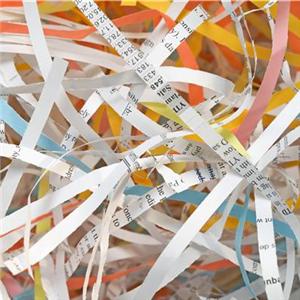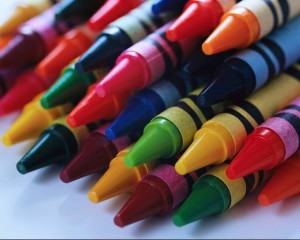It’s the end of another school year, and there are a lot of supplies left over: graded papers, book bags and sharpened pencils, just to name a few.
The summer vacation has started for students. So, instead of parking it in front of the television, get hands on with some eco-crafting. Not only can you teach your kids the importance of reuse and recycle, but you can also shed that unwanted waste. Here are eight great ways to reuse or donate some of the most common school waste items.
1. Recycle it yourself
So you’ve heard a thousand times that you can put leftover paper into the recycling bin, but did you know that you can recycle paper yourself? It can be newspaper, left over bits of construction paper, notebook paper or printer paper. Regardless, you can turn this paper into something new. Ecokids tells you how to make your own recycled paper.

Don't trash your leftover paper! Recycle it yourself at home. Photo: Directnews.co.uk
What You’ll Need
- Paper
- Blender or wire whisk
- Water
- Bucket
- Square pan (at least 8 cm deep)
- A piece of window screen that fits inside the pan
- Iron or rolling pin
- Measuring cup
- Towels
- Color dye
What You’ll Do
1. Tear the scrap paper into tiny pieces and soak them in a bucket of hot water for about 30 minutes. Put a handful of the soaked paper into the blender and mix until mush. Or if using a whisk, beat the mixture until it is a creamy pulp. Add a small amount of vegetable scraps or dye for color (or even leaves for added texture).
2. Pour the blended pulp into a measuring cup. Pour roughly 3 cm of water into the pan. Put the screen into the pan and pour one cup of the paper pulp onto the screen.
3. Spread the pulp evenly in the water with your fingers. It should feel kind of mushy. Lift the screen and let the water drain.
4. Lay the pulp-covered screen face down on a cloth (tea towel) or in between some newspaper. Lift the screen away, leaving the paper pulp on the cloth. Cover with another cloth and iron with a hot iron, or use a rolling pin to flatten and press out excess moisture. Let the pulp dry for at least 24 hours.
5. Once it’s dry, use the newly made paper to create greeting cards for your friends and family, or use it to write a letter to your member of parliament encouraging more recycling in your community.
2. Turn crayons into decorations
Have you ever opened up the crayon box and found a slew of worn out or broken crayons? What if you could put those crayons to good use instead of throwing them into the trash can? Consider making them into candles.
What You’ll Need
- Crayons
- Wax carton
- Paraffin wax
- Two full ice cube trays
- Double boiler, old coffee can or saucepan
- White packing string
What You’ll Do
1. Trim the top off of the wax carton so that what is left behind measures six inches.
2. Cut the string approximately eight inches long.
3. To make sure that the wick burns easier, bread three pieces and braid them together. To tie the ends together, use small pieces of string. Your candle holder may be of any design just as long as it is not flammable.
4. Melt three pounds of paraffin wax in the double boiler. You may want to cut it into small chunks for it to melt faster. Wait for about fifteen to twenty minutes until all the wax melts.
5. Peel the papers off the old crayons while waiting for the wax to melt to help save time. You can tell your child to choose the colors that he or she would like the candle to have. Try mixing different colors.

Colorful crayons now can equal colorful candles! Photo: Tiof.wordpress.com
6. Add the crayons to the wax only after it has completely melted to achieve the best results.
7. Once the crayons and wax have melted together, remove the mixture immediately from the stove. Pour them into the candles carefully and add your choice of scent.
3. Get to the point
You are rooting around in your kid’s backpack, and you find some pencils that look like they’ve seen better days. Think creative. While the erasers are worn, and the pencil itself was sharpened down to almost nothing, they can still be used for crafts. One idea from Highlights is to turn them into a wind chime.
What You’ll Need
- One long pencil
- Nine short pencils
- Sandpaper
- Thread
- Scissors
- Glue
What You’ll Do
1. Flatten the points of all the pencils by rubbing them on sandpaper.
2. Tie the ends of a length of heavy-duty thread to the ends of the long pencil to form a hanger.
3. Tie a length of thread to the eraser end of each short pencil. Tie the other end of each thread to the long pencil. Space them evenly.
4. Cut off the extra thread ends. Cover each knot with glue. Let them dry.
5. Hang your chimes where they can catch a breeze
4. Piece it back together
Many teachers have the daunting task of picking up the broken pieces of chalk and tossing them into the wastebasket. But what if you could take that chalk and make new chalk? The good news is that you can.
What You’ll Do
- Take the left over pieces of chalk and use scissors, a file or a knife to cut it into tiny pieces.
- Crush the pieces as small as you can with our finders into a small bowl.
- Moisten the chalk with water and roll into the desired shape.
- Let it dry.
- It’s ready to use!
5. Get creative
Maybe your kids have found that an empty pen makes an excellent spitball launcher, but we’ve got a few other ideas. Ones that are a lot less, well, gross. It’s amazing how many uses you can get out of old pens.
What You Can Do
- Bead holder
- Sewing caddy
- Garden labels

Have an old backpack? Donate it to a local charity. Photo: Ctstateu.edu
6. Lend a helping hand
Every year students go out and buy new books bags, but what happens to the old ones? Most of those bags land in the wastebasket where they will be sent to a landfill. But what if there was another option? One that would allow you to give back to the community? Well, there is.
One big solution for the surplus of used book bags is to donate. Contact your local community organizations to see what families may be in need of a book bag. If someone is not able to use it, you can always recycle them. Contact your local recycling center to see if they accept used book bags.
7. From your tray to the garden
So maybe food was not the first thing that came to mind when you thought of school waste. But many schools across the country toss out perfectly good food, which simply winds up in landfills. However, some schools are trying to make amends by having their students sort their trash.
The bins that students use to sort not only include recyclables, but also compost waste such as left over french fries, pizza or any other uneaten food. It’s estimated that about 80 percent of a school’s waste comes from the cafeteria! So by sorting out the recyclables from other waste, schools are able to cut garbage costs. Talk about a win-win situation.
8. Think green by minimizing waste
This is where the rubber meets the road. The bottom line is less is more. The less waste a school can produce, the better off they’ll be. If your a teacher, you can apply these techniques right in your classroom. If your student, share these tips with your school and see if they will get on board.
What To Do
- Minimize handouts
- Spell check and proof read documents on the computer screen (cuts down on the amount of printer paper used)
- Start a “supply” swap – what’s old to you is new to someone else
- Reuse binders and folders
Those are just some options to get you started, but there are plenty of ideas. From simply recycling leftover paper to donating or reusing supplies, the possibilities are endless. It’s taking the time to look for opportunities where they did not appear before that makes a world of difference.

Brandy Norleen
Brandy Norleen is a technical writer at a firm in Delaware. She is also a freelance writer and editor.
Link: http://earth911.com/blog/2009/06/01/8-ways-to-green-school-waste